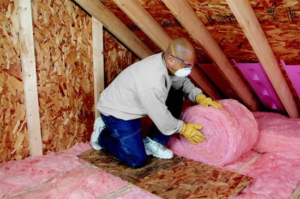Roofing is the covering of a building’s uppermost part, designed to protect it from rain, snow, intense sunlight, and wind. It can be constructed in a wide variety of forms.
A roof’s slope is called its pitch and is calculated by measuring rise over run. A ridge is the meeting line of two intersecting roof planes; specific shingles are used to cover this area.

There are a variety of materials that can be used in roofing, each with its own set of advantages and disadvantages. Some of the most popular options include asphalt shingles, metal and slate. Choosing the right material can help to increase the value of your home as well as provide protection from harsh weather conditions.
There is also a growing interest in the use of membrane roofs. These are typically applied in large sheets, which limits the number of seams that can leak or allow water to penetrate into living areas below. Membrane roofs are often black, which absorbs heat and may lead to higher energy costs, but there are also white options that are more reflective.
Wood shingle roofing is another option that is available in a variety of colors. It is an environmentally friendly choice that is durable and provides a high level of insulation. However, it is prone to damage and insect infestation and requires regular maintenance. It is also expensive and can add a significant amount to the cost of a new roof.
Clay tiles are another natural roofing option that is durable and can be found in a range of colors and styles. They are a good choice for warm climates and can last up to 50 years. However, they are very heavy and can put a lot of stress on the structure of a house. They also require regular maintenance and are more prone to moisture absorption than other roofing materials.
A modern alternative is synthetic roofing. This is made from layers of felt impregnated with asphalt that are applied hot. It is suitable for flat or low-slope roofs and can be very durable. It is not as attractive as other roofing materials, but it is less costly and can be installed quickly.
When choosing a roof, make sure it is covered by a manufacturer warranty. This will prevent a lot of repair costs in the future if something goes wrong with your roof. Many people don’t realize that their roof warranty has lapsed until it is too late and they are left with a huge bill.
Installation
Any part of your home takes a beating from the elements: rain, wind, hail, bitter cold, blazing heat, and sunshine. Your roof especially gets beat up, so a well-installed one is a worthwhile investment that will protect your property and help you save money on energy costs.
Your roofing contractor will set up safety measures to keep the work area safe while tearing off your old roof and installing the new one. Tarps and wooden boards will cover the driveway, patio or deck so that debris won’t fall on vehicles or damage your landscaping. The crew will also set up protective barriers in the attic and pool area (if applicable), cover your outdoor furniture to prevent dust and sun exposure, move any vehicles out of the way to ensure that they are not damaged, and put down a vapor retarder to reduce the buildup of moisture and mold.
When the roof is ready for shingles, your contractor will install underlayment to prepare the surface for the shingles. This material goes under the shingles to protect it from moisture and to hold the shingles in place. After the underlayment is in place, your contractor will nail the shingles into place with a pattern of close nails at the edges and spreading out toward the middle. He will then install a row of ridge shingles at the top of your roof.
Proper ventilation in your attic is important to keep moisture and heat from damaging the insulation and roof structure. Vents like soffit vents and ridge vents remove moisture and regulate the temperature inside your home, cutting energy costs. Hip and ridge shingles are available in a variety of colors and styles and give your roof a finished look while protecting it from weather elements.
Maintenance
Any part of your building’s exterior can get assaulted by the elements, but your roof takes the brunt of it all. The constant beating of hot sun, rain, wind, hail, bitter cold, and falling leaves is enough to cause damage or even the need for a reroof. But a roof that’s properly maintained can withstand those blows and continue to look beautiful year after year.
A roof needs to be inspected regularly to spot any problems before they escalate. Those problems can range from a few missing shingles to the need for a complete replacement. A typical maintenance inspection starts with a walk around the roof to look for dents, rotting or missing shingles, as well as checking for leaks in the attic, if applicable. The caulking around the chimney and vent pipes should also be checked. If the caulk is coming away or lifting in places, it should be scraped and reapplied. This will protect against future water leaks into the home or business. Flashing is another area that should be inspected on a regular basis. It is a thin material that typically made of galvanized steel that is installed to direct water away from areas where the roof plane meets a vertical surface like a chimney or dormer. This is where leaks commonly occur.
Other maintenance tasks include trimming tree branches that hang over the roof to prevent them from tearing off during stormy weather, as well as looking for any signs of organic growth on the soffit and fascia, which can also cause leaks and damage. Chimneys should be cleaned of a soot-like substance called creosote on a regular basis. And vents and skylights should be inspected to make sure that the seals are intact and working properly.
Repairs
Unlike giving your home a fresh coat of paint or replacing cabinets, roof repairs are a larger investment. They can be the difference between a long-lasting home and a rotting or leaking one. With regular maintenance and inspections, roof repairs can keep your roofing structure strong. They also prevent minor issues from escalating into major problems, saving you money and stress in the long run.
Repairs typically involve repairing or replacing damaged shingles, sealing leaks, and fixing other minor structural damage. They can be done for a fraction of the cost of a full roof replacement and may be more cost-effective for homeowners who don’t want to commit to a complete project right away. However, patchwork repairs may not address underlying damage and could result in recurring leaks and other problems.
Re-roofing involves putting a new layer of shingles on top of your existing roofing material. It is usually the cheapest option when it comes to roofing, but it doesn’t last as long as a new roof. Plus, since you are covering over the existing shingles without removing them, you won’t be able to see any signs of damage or wear that might exist underneath.
If you notice a sagging or uneven roof, you should consult a professional roofer immediately. These symptoms can be caused by major structural damage or simply indicate that the existing materials are aging and starting to fail. Other warning signs include leaks or water stains in your ceilings and walls, which may indicate faulty gutter systems or weakened structural supports.
